

TeacherCopyright_chart-3. Cb_copyright.swf (application/x-shockwave-flash Object) Classroom Resource Resources tagged as "copyright" Need to create an online image library?

Worried about copyrighted pictures online? Have students take and upload their own images using Troovi. It is a web application to exchange photos from a bunch of different sources easily in one single place. There is a "how to" video on the main page. Please note that there are two different types of use for this site, free and premium. Tag(s): copyright (44), images (202), photography (129) In the Classroom User must be able to locate files on your computer to be uploaded. Content is private, in that, only the people with which the URL is shared have access to the photos.
This tool can be useful in so many different areas. Creative Commons for K-12 Educators. Update: The second round of this facilitated course is located at It is open for sign-up through August 4, 2013.
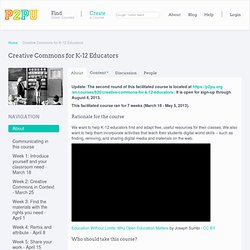
This facilitated course ran for 7 weeks (March 18 - May 5, 2013). Rationale for the course We want to help K-12 educators find and adapt free, useful resources for their classes. We also want to help them incorporate activities that teach their students digital world skills -- such as finding, remixing, and sharing digital media and materials on the web. Education Without Limits: Why Open Education Matters by Joseph Sumbi / CC BY Who should take this course? Elementary, primary, or secondary school educatorsAnyone interested in primary education who would like to obtain the skills listed below What will I learn? Copyright for Educators (US) This is a course for educators who want to learn about US copyright law in the education context.

P2PU also offers a similar courses for Australia, if that content is more appropriate. Educators who are not in the US are welcome to sign up, too, if they want to learn about copyright law in the US. The course is taught around practical case studies faced by teachers when using copyright material in their day-to-day teaching. Copyright and Fair Use - UMUC Library. Disclaimer The information presented here is only general information.
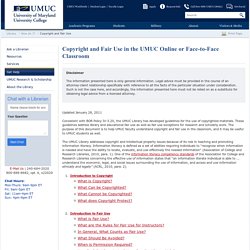
Legal advice must be provided in the course of an attorney-client relationship specifically with reference to all the facts of the particular situation under consideration. Such is not the case here, and accordingly, the information presented here must not be relied on as a substitute for obtaining legal advice from a licensed attorney. Updated January 28, 2011 Consistent with BOR Policy IV-3.20, the UMUC Library has developed guidelines for the use of copyrighted materials.
The UMUC Library addresses copyright and intellectual property issues because of its role in teaching and promoting information literacy. CopyRIGHT Pathfinder on Copyright Law for Librarians. The second CopyRIGHT Pathfinder, which is part of the 2013 Copyright Community, is now available.
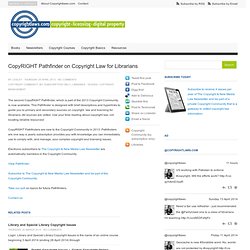
The 10 Most Influential Brands on Social Media. Key Milestones In Social Media Law [Infographic] It’s the Wild West out here on the Internet.
![Key Milestones In Social Media Law [Infographic]](http://cdn.pearltrees.com/s/pic/th/infographic-socialtimes-21808611)
While individual social media companies face lawsuits over copyrights, privacy and antitrust violations, Washington debates bills like SOPA and PIPA to help redefine the law for the Digital Age. This infographic from the Socially Aware blog examines the key moments that led us to what can only be described as a hot, electrically-charged mess. The timeline begins appropriately in 1984 with Sony v. Universal Studios, when the U.S. Top 10 Tips for Images and Copyrights to Avoid a Social Media Disaster. Copyrights and social media always seem like this gray area that brands walk on eggshells over or just ignore completely, especially when it comes to images.
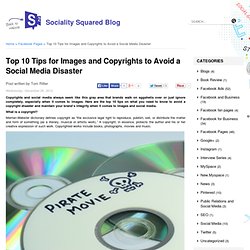
Here are the top 10 tips on what you need to know to avoid a copyright disaster and maintain your brand’s integrity when it comes to images and social media. What is a copyright? Merrian-Webster dictionary defines copyright as “the exclusive legal right to reproduce, publish, sell, or distribute the matter and form of something (as a literary, musical or artistic work).” A copyright, in essence, protects the author and his or her creative expression of such work. Copyrighted works include books, photographs, movies and music. Fair Use. PowerPoint Presentation - Copyright and Fair Use. Learning Resources: Copyright Issues. What is intellectual property?

Is it okay to copy information such as words and pictures from a book, a CD-ROM, or the Internet? Do I need to get permission to link to someone's website? How can I tell if a student has copied their report from the web? Intellectual Property Have you ever written a story, created a work of art, or composed a song? Copyright Website. U.S. Copyright Office. Guide to Citing Online Sources. Page 1 of 2 Do you ever use the Internet to get information or pictures for your reports?
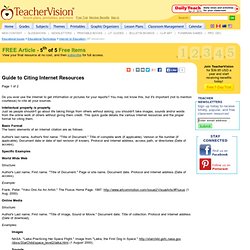
You may not know this, but it's important (not to mention courteous) to cite all your sources. Intellectual property is property. Just as people shouldn't go about life taking things from others without asking, you shouldn't take images, sounds and/or words from the online work of others without giving them credit. This quick guide details the various Internet resources and the proper format for citing them. Basic Format The basic elements of an Internet citation are as follows: Author's last name, Author's first name.
Specific Examples World Wide Web Structure: Author's Last name, First name. Example: Frank, Peter. Online Media Author's Last name, First name. Copyright Fair Use and How it Works for Online Images. You’ve heard the adage that a picture is worth a thousand words, but when that picture is protected by copyright, the picture is only worth three words: cease and desist.

OK, that’s kind of a lawyer joke. But it illustrates how protective people are about finding their images used online without permission. Copyright laws were established not to give the author the right to deny their work to other people, but instead to encourage its creation. Article I, Section 8, clause 8, of the United States Constitution states the purpose of copyright laws is “to promote the Progress of Science and useful Arts, by securing for limited times to Authors and Inventors the exclusive Right to their respective Writings and Discoveries.” It’s a delicate balance between the rights of the creator and the public’s interest.